Round Pond Schoolhouse Association
1426 State Route 32 Round Pond, ME 04564
1426 State Route 32 Round Pond, ME 04564
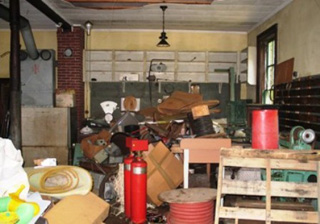
First Floor almost cleared of trash. The back wall can now be seen. A total of 12 truck containers of trash, PVC piping, broken pieces of this and that, and construction debris was hauled off to the dump. 50 truck tires, which for some reason had been carried up the stairs and dumped, were thrown out the upper windows and hauled off. 6 cartons of porcupine poop and quills were scraped off the floor and dumped [they had made a tidy pile in the back corner of the 2nd floor classroom]. As we cleared the structure and removed add-ons, it became easier, bit by bit, to understand the original design.First, overlying the lower S.E. corner floor, we sledge-hammered and hauled off a 12ft sq pad of cement reinforced with chain link fencing; we also removed the surrounding asbestos wall panels. We understand that an open dipping vat of highly flammable degreasing metal cleaner was used here. We then started on a smaller but very hard cement pad nearby which needed jack hammering to remove. This was taken down to the level of the floor joists. This pad had been poured through the cut-away floor to the bedrock in the cellar to support the stamping machine. The flooring in this location would later be patched. Getting back to an even floor.
First, overlying the lower S.E. corner floor, we sledge-hammered and hauled off a 12ft sq pad of cement reinforced with chain link fencing; we also removed the surrounding asbestos wall panels. We understand that an open dipping vat of highly flammable degreasing metal cleaner was used here. We then started on a smaller but very hard cement pad nearby which needed jack hammering to remove. This was taken down to the level of the floor joists. This pad had been poured through the cut-away floor to the bedrock in the cellar to support the stamping machine. The flooring in this location would later be patched.
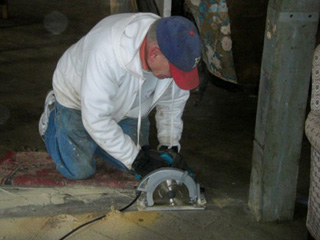
First cut in lifting the machine shop floor. Bill Morton offered to remove the machine shop super-flooring in exchange for the boards to be used in his barn construction. These were machine oil impregnated 2X6 inch boards, as long as 10ft, set diagonally over the original schoolhouse floor. They had been closely nailed with 6 inch spikes which were a challenge to pull out. As we revealed the original floor underneath we began to see a blueprint of the interior schoolhouse architecture – the cloakroom partitions, thresholds, center staircase and closets, galvanized pad for the wood stove, and tin floor patches.
One disappointment was that the original flooring was also machine oil impregnated and would never air out sufficiently or be sandable for refinishing. The original flooring is random width 7/8 inch fir. Where it was not expected to be visible, scrap boards were used.
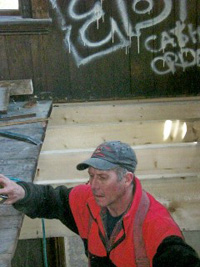
Splicing joists where machine shop stairs cut through. (Some of the more innocuous graffiti.)
There were originally 4 cloakrooms flanking the stairs - 2 up and 2 down. The boys' were on the S. side and the girls' on the N. When we received the schoolhouse, 3 of the 4 had been removed (along with the interior walls and center staircase), leaving only the upper S. room with its robust 4 panel grained doors and a dropped ceiling. This had been painted green with brown woodwork, and was used as an office for Masters Machine.
Framed cloakroom. (Note wall patch where front door had been removed in the 40's.)
It charmingly retained its 'Faculty' sign on the door. The area of the N. cloakrooms had been cut into for the pieced-together machine shop stairs. In the upper girls' cloakroom the teacher had fancied it up with painted stencil flowers below the coat rack board and had added a mirror, and curtains (which, in tatters, looked like 'Lincoln's deathbed' paintings).
The 'blueprints' on the floor showed us where to replace the partition walls. Carpenter Ken Vinal and his framing crew rebuilt them, and the schoolhouse began to return to its original appearance.
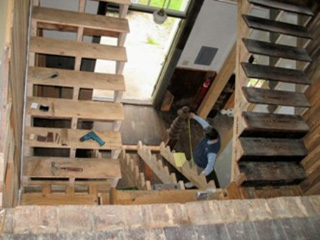
Until the machine shop revisions, there had been a gracious center staircase just inside the front door. By combining memories, found remnants, and the floor 'blueprint' it became apparent that there had been 9 wide steps up to a landing, then a right angle turn with a side step to right or left (separating girls from boys), and 'dog legs' of 9 steps on each side leading to the upper floor cloak rooms. The staircase well was open and there was a balcony in front of the upper front windows from where the rope to the bell in the belfry could be pulled. [From these windows there is a good view into the bay, and the students were instructed to keep a watch for enemy submarines in WWII. They also volunteered for evening airplane spotting. A telephone was installed in those years with a direct line to the Brunswick Naval Air Station for just this pupose. Under the staircase was a closet with stairs going down to the cellar so that, in the morning before school started, the boys could go down and bring up the firewood for the day. We have the old wood box.
The entire staircase system was sheathed in bead board, and the found remnants show that the railings were supported by bead board panels, not banisters. We have short pieces of the railing and were able to dead match longer lengths from a salvage company.
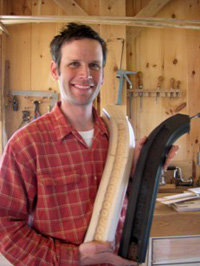
Originally, the railings ended at the foot of the stairs with a gracious curve to a newel post on each side. We had one of these curved pieces. Ken Kortemeier, from the Carpenters' Boat Shop, hand carved its mirror image for the other side - an extraordinary piece of carving as the railing curves in 3 planes. The dog leg staircases had been cut down but were available for repair because they had been used by the machine shop as a patched together staircase they built into the N.E.corner. This passed in front of one of the large windows and cut through to the 2nd floor. The old stairwell had been closed off and a trap door installed there in order to use the 2nd floor for office and storage.
We found a rotten remnant of one of the two 10 inch diam. mahogany newel posts mired in the cellar mud. Using this as a pattern, a pair was turned by the Woodturning School in Damariscotta, matched as closely as possible to the originals. Additionally, we received a gift of 1850's newel posts some of which would be spliced and matched to those we found, for the turn-backs and the 2nd floor landing.
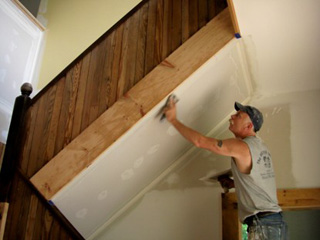
Rebuilding the staircase system was the task of a master carpenter and restorationist - Mike Alderson. It involved analysing the bits and pieces found around the building and matching them to the floor 'blueprint', then building it up piece by piece using primarily old wood (only the lower 9 stair treads had to be new lumber - lengths of 2X12 southern pine, special ordered from S.Carolina). Calculations were complicated by the 2 floors not being level and the butting walls askew. But the final results were gorgeous. Visitors no longer wondered why we were trying to save this old relic of a building.
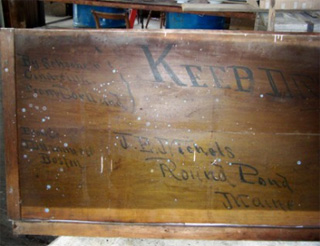
Back of Blackboard... 'By Schooner Cinderella from J. L. Hammett, Boston, to J. E. Nichols (ie King Ro) Round Pond, Maine - KEEP DRY'. The blackboards were mostly still available to us as they had been used as peg boards by the machine company. They would be repaired and rehung. The wooden groove strips that held them to the wall were copied by Mike Alderson where missing. The chalkboard chair rails were, in many cases, also missing. Likewise, much of the robust original molding had been pulled off, discarded or cut into short lengths for various utilitarian needs.
Four doors (2 up and down) at the rear of the building originally opened to the 2 story 1925 outhouse addition. That was the year the law went into effect that there had to be indoor access to 'hygienic and decorous' facilities. The boys' and girls' pasageways were separated, the wall construction rough and exposed, there was a 'long drop down' with the upper floor dumping further out than the lower floor. These 4 doors were found in the building debris and were repaired, patched(by Kim Jesperson) and rehung, awaiting passage to a reconstructed outhouse addition. Our plans were for a composting toilet - within the old cement cesspit foundation - which would have the appearance of an outhouse. There would also be storage space [for stacked chairs and tables] and a back exit.